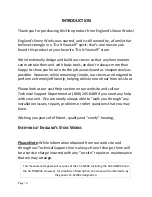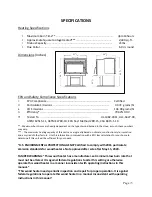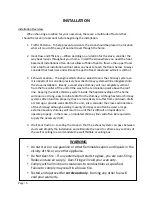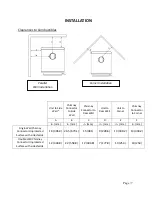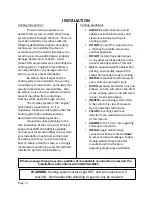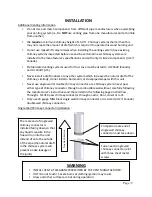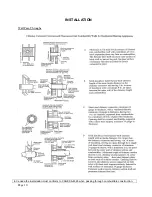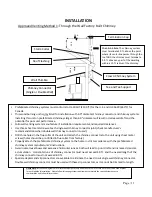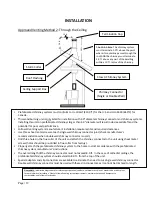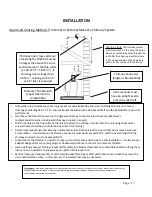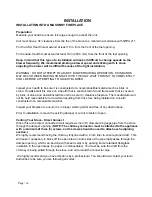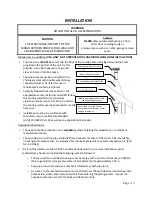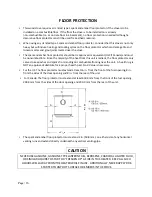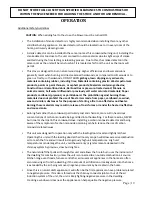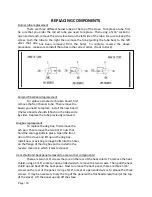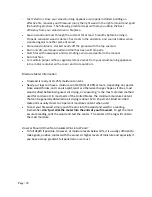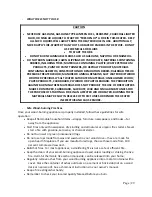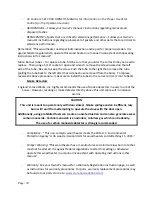
age | 18
OPERATION
•
England’s
Stove
Works,
Inc.
always
recommends
the
use
of
a
magnetic
stove
thermometer,
so
that
the
temperature
of
the
unit
can
be
monitored.
When
using
a
magnetic
stove
thermometer,
locate
the
thermometer
above
the
door
on
either
the
left
or
right
side
of
the
stove
and
use
the
following
temperatures
as
rough
guidelines
to
determine
the
burn
rate
and
heat
output
level
of
the
stove:
o
Normal
wood
stove
operation
should
occur
between
350°F
(177°C)
and
550°F
(288°C),
with
350°F
(177°C)
to
450°F
(232°C)
being
a
low
to
medium
heat
output
level
and
450°F
(232°C)
to
550°F
(288°C)
being
a
medium
to
high
heat
output
level.
Operating
the
stove
at
600°F
(316°C)
would
be
considered
the
maximum
continuous
operating
temperature
permissible
and
unit
damage
may
result
from
operating
at
that
high
of
a
burn
rate
for
extended
time
periods.
Allowing
the
unit
to
reach
750°F
(398°C)
or
higher
is
defined
as
over
‐
firing
and
will
result
in
unit
damage.
•
The
optional
room
air
convection
blower
was
designed
to
extract
the
maximum
amount
of
heat
from
the
stove,
for
the
highest
possible
heat
transfer
into
the
room.
Since
the
blower
is
so
efficient
at
removing
heat
from
the
unit,
it
is
very
important
to
only
operate
the
room
air
blower
after
a
fresh
wood
load
has
been
allowed
to
burn
for
at
least
thirty
(30)
minutes.
Allowing
a
fresh
load
of
wood
to
burn
without
the
blower
on
ensures
that
the
entire
unit
reaches
proper
operation
temperatures
and
that
the
secondary
combustion
system
is
functioning
properly.
Additionally,
follow
the
guidelines
below
for
acceptable
blower
speeds.
•
When
using
the
optional
room
air
convection
blower
(Part
No.
AC
‐
16,
or
you
can
upgrade
to
the
AC
‐
30),
the
blower
should
be
operated
as
follows
depending
on
heat
output
level:
Burn
Rate
High
Medium
High
Medium
Medium
Low
Low
Blower
Speed
AC
‐
16
High
High
Low
Low
Low
Blower
Speed
AC
‐
30
High
Medium
High
Medium
Medium
Low
Low
Creosote
–
Formation
and
Need
for
Removal
When
wood
is
burned
slowly,
it
produces
tar
and
other
organic
vapors,
which
combine
with
expelled
moisture
to
form
creosote.
The
creosote
vapors
condense
in
the
relatively
cool
chimney
flue
of
a
slow
‐
burning
fire.
As
a
result,
creosote
residue
accumulates
on
the
flue
lining.
When
ignited,
this
creosote
makes
an
extremely
hot
fire.
The
chimney
and
chimney
connector
should
be
inspected
at
least
once
every
two
months
during
the
heating
season
to
determine
if
a
creosote
buildup
has
occurred.
If
creosote
has
accumulated,
it
should
be
removed
to
reduce
the
risk
of
chimney
fire.
DO
NOT
USE
GRATES
OR
ANDIRONS
OR
OTHERWISE
ELEVATE
FIRE
–
BUILD
WOOD
FIRE
DIRECTLY
ON
HEARTH
DO
NOT
OPERATE
WITH
THE
MAIN
DOOR
OPEN
–
OPERATING
THE
STOVE
WITH
THE
MAIN
DOOR
OPEN
WILL
CREATE
AN
OVER
‐
FIRE
In
the
event
of
a
creosote
or
soot
fire
(chimney
fire),
close
the
air
control
on
the
stove,
contact
the
local
fire
department
and
get
out!
Do
not
throw
water
on
the
fire!
Contact
your
local
fire
authority
for
more
information
on
how
to
handle
a
chimney
fire
and
P
develop
a
safe
evacuation
plan
for
you
and
your
family
in
the
event
of
a
chimney
fire.

